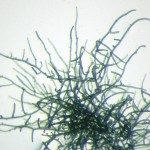Lien vers Pubmed [PMID] – 37406865
Lien DOI – 10.1016/j.toxicon.2023.107205
Toxicon 2023 Jul; 232: 107205
Toxic benthic mats of cyanobacteria are associated with water quality problems and animal poisonings around the world. A strain of the filamentous cyanobacterial genus Kamptonema was isolated from a water bloom in the Baltic Sea four decades ago and later shown to produce cylindrospermopsins. However, the exact habitat of this strain remains unclear and cylindrospermopsins have not yet been reported from water blooms in the Baltic Sea. Here, we report the isolation of Kamptonema sp. UHCC 0994 from a benthic microbial mat collected in shallow water on the coast of Helsinki. We obtained draft genome sequences for the Kamptonema spp. PCC 7926 and UHCC 0994 strains that were isolated from the Baltic Sea. These genomes were 90-96% similar to previously studied Kamptonema sp. PCC 6506 and Kamptonema formosum PCC 6407, which were isolated from benthic and North American freshwater environments, respectively. The genomes of all four Kamptonema strains encode complete cylindrospermopsin biosynthetic gene clusters. We detected the production of cylindrospermopsin and 7-epi-cylindrospermopsin in the four Kamptonema strains using high-resolution liquid chromatography mass spectrometry. The four strains encode genes for producing gas vesicles distributed in two to three different regions of their genomes. Kamptonema spp. UHCC 0994 and PCC 7926 have both retained the ability to regulate their buoyancy when grown in liquid culture. Together this suggests that these toxic cyanobacteria may exhibit a tychoplanktic lifestyle in the Baltic Sea. This study suggests that microbial mats containing cyanobacteria could be a source of environmental toxins in the Baltic Sea.

